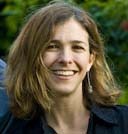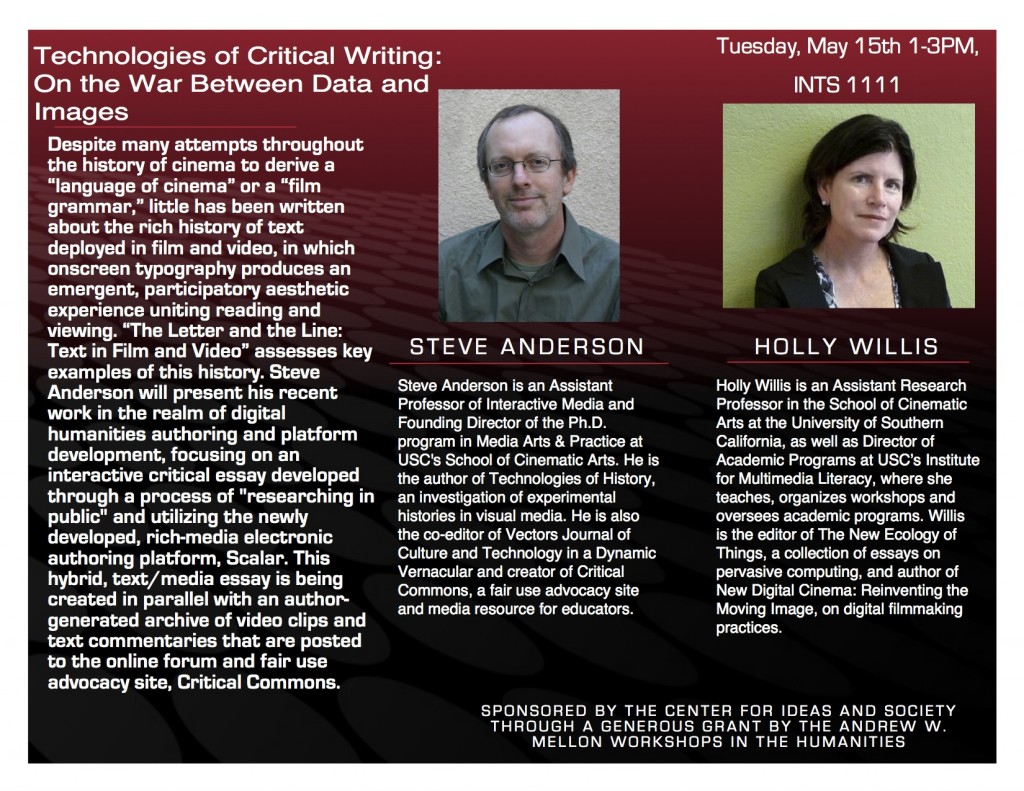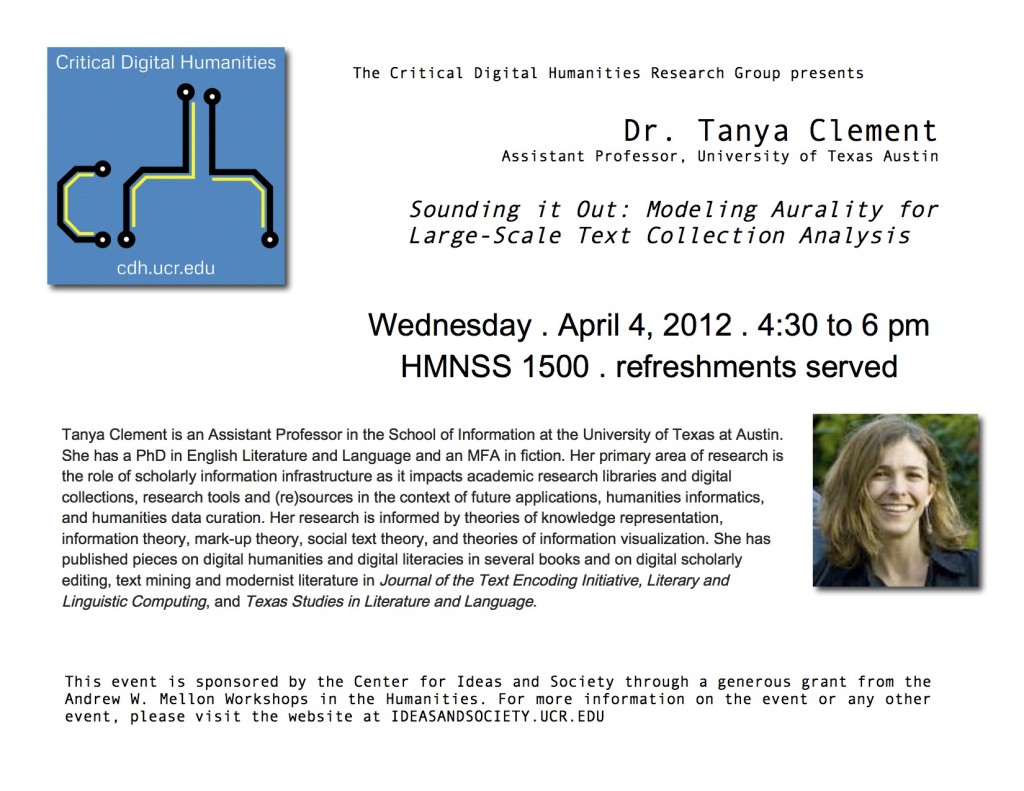CDH event – Technologies of Critical Writing: On the War Between Data and Images
May 9th, 2012
Steve Anderson
Tuesday, May 15th 1-3pm in INTS 1111
Technologies of Critical Writing: On the War Between Data and Images
by USC professors: Steve Anderson and Holly Willis
Despite many attempts throughout the history of cinema to derive a “language of cinema” or a “film grammar,” little has been written about the rich history of text deployed in film and video, in which onscreen typography produces an emergent, participatory aesthetic experience uniting reading and viewing. “The Letter and the Line: Text in Film and Video” assesses key examples of this history. Steve Anderson of USC will present his recent work in the realm of digital humanities authoring and platform development, focusing on an interactive critical essay developed through a process of “researching in public” and utilizing the newly developed, rich-media electronic authoring platform, Scalar. This hybrid, text/media essay is being created in parallel with an author- generated archive of video clips and text commentaries that are posted to the online forum and fair use advocacy site, Critical Commons.
Orientation for the Designated Emphasis in Book, Archive, and Manuscript Studies
April 27th, 2012
Steve Anderson
Orientation for the Designated Emphasis in Book, Archive, and Manuscript Studies
time and location: May 2nd Noon-1:30
UCR English Department Conference Room (HMNSS 2212)
GSEA invites UCR graduate students for an orientation regarding the new Designated Emphasis in Book, Archive, and Manuscript (BAM) Studies. Dr. Adriana Craciun, from the English Department will provide an overview of BAM and answer questions. This event is open to graduate students from all departments, so be sure to invite colleagues from other fields of study.
If you have questions in advance that you would like to be addressed during the orientation, please email them to Sarah Lozier (slozi@student.ucr.edu) or Anne Sullivan (asull003@student.ucr.edu)
While here in our corner of the net, we are working on figuring out the potentials of “contemporary transmedia theory and practice” including interdisciplinarity and collaboration, the MLA is concerned with getting a grip on the parameters for evaluating digital scholarship and the structures both departments and individual scholars need to support one another. After twelve years, the MLA has issued updated guidelines to address the interdisciplinary, collaborative, and practical aspects of digital scholarship.
Because we require institutional legitimacy to have access to the normal trajectory of an academic career, these guidelines are important and necessary. If we want to be able to make solid arguments with traditionalists like Stanley Fish But as it is important to also be critical of state apparatuses, I would like to point to the ways in which these guidelines tend to contain the very openness that is the potential of this work. Of course I’m not arguing for a reprieve from the intense rigors demanded of any kind of scholarship. But I do find that efforts to understand that comprise lists and limiting language are generally about limiting the unexpected, the chaotic, the weirdness that a field like digital humanities (especially when it includes the critical) is constantly renewing by its very nature.
So while the MLA guidelines are meant, in all consciousness, to support the varied ways digital scholarship can exist and to encourage departments interesting in including digital scholars in their faculty to open themselves up to “invasion” from other disciplines or formats for scholarship that may not include paper publications, it also begins the fencing-in that is the road to “state machine” status (to use a D&G concept) or in other words, it begins to frame the ways in which even such untraditional projects as bizarrely mapped digital archives or interactive, spatial texts can be limited to narrowly defined categories and institutional parameters.
Yes, it would seem so. Or at least, with the help of a team of brilliant researchers made up of humanities and digital technologies scholars, computers can at least be asked to try and differentiate Gertrude Stein texts from each other, from other highly sophisticated western literary works, and from a cookbook. The punchline? One such computer consistently confused Stein’s Tender Buttons with The New England Cookbook, which was highly popular during Stein’s day. While this may not seem like much of an accomplishment to the average humanities scholar (indeed, as someone on the verge of PhD Qualifying Exams, I’d be quite pleased if this were my qualifying task, instead), it represents a significant accomplishment in the digital humanities, and provides compelling evidence for the ongoing use value of computing in the study of literature.
This brief anecdote was a small portion of a talk given several weeks ago by Dr. Tanya Clement, of UT Austin, to the Critical Digital Humanities Research Group at UCR. Sponsored in part by The Center for Ideas and Society Mellon Workshop, the event was entitled “Sounding it Out: Modeling Aurality for Large-Scale Text Collection Analysis.” Dr. Clement presented research from her collaboration with a computing center at UT Austin, a project that creates computer models for analyzing sound in literary texts. It emerged several years ago out of a drive to expand the affordances of digital archives to include models that could recognize and work through texts based on the way we read them, not just based on the ways we’re currently able to upload and store them (images, text, etc). In this case, the analysis sought to understand how we might argue for the meaning of sound in literary works—not simply sound as part of form or delivery, but sound as meaning.
The project leaders created a set of protocols that would allow them to come up with a usable “knowledge representation” of texts based on sound, even taking into consideration the subjective nature of sound. For example, different readers will read the same text quite differently, based on numerous factors including regional dialect, speed, intonation, enunciation, etc. A central question then became how to make the best guess at how a text actually “sounds,” given these considerations.
Dr. Clement and the research team selected as their primary text, which they then put through a series of digital translations, from text to code to representation to “best guess at sound.” Now, this is obviously a serious reduction and is admittedly a paraphrase, so please forgive my skipping over most of the technical details, as it’s quite elaborate and I probably wouldn’t rehash it very faithfully anyways. I can say this much, however—that the poems were cycled first through a program called OpenMary, then SEASR, and then through ProseVis (someone out there (myself not included) is reading this and knows exactly what this means, and is probably excited about it—I hope so, at least). The end result of this process was a series of data maps that allowed not only some fascinating analysis (which I’ll detail shortly), but which also functioned for Dr. Clement and team as “hypothesis generators,” which allowed them to ask questions such as “Do we care about sound in this poem? Does it matter to meaning?”
So I’ll skip now to flesh out the opening anecdote. The researchers entered 9 texts into the database, including Tender Buttons and two other Stein texts, plus the cookbook, some Joyce, the Iliad and the Odyssey, and more. Just to try to make sure the computer focused on sound, and not just noting the repetition of words, they eliminated words themselves from the analysis, focusing on data about the words and phrases, such as part of speech, accented syllables, phoneme, tone, and more. What they found was pretty remarkable.
Stein scholars have charged that Tender Buttons was written to reflect Stein’s domestic pleasures shared with Alice B. Toklas, her partner of many years. Thus, it’s been argued, Stein modeled the poems on a cookbook. As it turns out, when the computer was asked to recognize which phrases and patterns belonged to which of the 9 texts, it identified them correctly with a fair degree of accuracy. However, the text that it confused most frequently for Tender Buttons was The New England Cookbook. It also regularly confused the Iliad and the Odyssey for each other, which should indicate the relatively sound (ahem) results.
In any case, what all this may mean is that sound does mean. In other words, Stein wrote Tender Buttons not merely to evoke a cookbook through food references and word choice, but she made her poems sound like the recipes. As if we needed another testament to the genius that Stein herself so often and roundly proclaimed.
I went through the CDH website here, and I made quite a few revisions. The website was getting a little cluttered, which is a good thing since it’s being used a lot, but it did need some spring-cleaning.
Here’s a quick overview of changes:
→ the main navigation was cleaned up
– the About page is now incorporated into the Members page
→ the News navigation dropdown has been revised
– now the only dropdowns are “events” and “resources”
– all the other categories are still available as a dropdown in the sidebar
→ the Twitter sidebar widgets have been removed
– the CDH Twitter feed was mostly just posts from CDH itself (@UCRCDH)
– and #digitalhumanites can be reached in other ways
→ Links (mostly UCR related) have been moved from the sidebar to the footer
→ a new Calendar page has been added to the site (this is for CDH events)
→ the ability to post from iPhone and iPad WordPress apps has been turned on
Also, I added a new category called “techie stuff” where I’ll post info about updates to this site, as well as other things of interest regarding hardware, software, coding, and the digital engineering culture.
If anything looks weird, or if you can’t find something, or something isn’t working right, please send me an email.
Rather than have a standalone page for resources, I thought we could use “resources” as a post category. This will help keep the info that was previously listed (posted below), and it will allow for more dynamic content. Rather than having to edit a page, members can just add a new post using the “resources” category. I’ll also make “resources” a dropdown item under “News” in the main navigation.
Here’s the listing of initial resources:
Websites & Organizations
HASTAC (Humanities, Arts, Sciences, Technology Advances Collaboratory)
http://www.hastac.org/
ADHO (Alliance of Digital Humanities Organizations)
http://digitalhumanities.org/
Society for Cinema and Media Studies
http://www.cmstudies.org/
The American Studies Association
http://www.theasa.net/
Association of Internet Researchers
http://aoir.org/
DiGRA (Digital Games Research Association)
http://www.digra.org/
Rhizome
http://rhizome.org/
H-Net (Humanities and Social Sciences Online)
http://www.h-net.org/
TEI (Text Encoding Initiative)
http://www.tei-c.org/index.xml
ACH (Association for Computers and the Humanities)
http://www.ach.org/
A Few Journals
Covergence
http://con.sagepub.com/
Digital Humanities Quarterly (DHQ)
http://digitalhumanities.org/dhq/
Game Studies
http://gamestudies.org/1001
Games and Culture
http://gac.sagepub.com/
New Media & Society
http://nms.sagepub.com/
Vectors
http://www.vectorsjournal.org/
Historical GIS and Observations on the Nghe-Tinh Rebellion: Markets, Rice, and Religion
Thurs Apr 19, 12-2 PM
UCR History Department Library | HMNSS 1303
The Nghe-Tinh Soviets of 1930-1931, a rebellion against colonial authority in north-central Vietnam, have received extensive historical analysis but little in terms of geography and spatial relations. Dr. Del Testa uses a historical GIS (geographical information system), blending statistics with digitized maps, to examine correlations between wealth, religion and space to reexamine the Nghe-Tinh Soviets movement on a broader scale. This particular presentation focuses on some preliminary analysis of relationships between protest locations and such factors as proximity to markets, types of rice produced, and the relationship of religious affiliation to revolt.

The Center for Ideas and Society Mellon Workshop
Critical Digital Humanities Research Group
Presents
Sounding it Out: Modeling Aurality for Large-Scale Text Collection Analysis
Wednesday, April 4th 4:30-6:00 PM HMNSS 1500
Dr. Tanya Clement is an Assistant Professor in the School of Information at the University of Texas at Austin. She has a PhD in English Literature and Language and an MFA in fiction. Her primary area of research is the role of scholarly information infrastructure as it impacts academic research libraries and digital collections, research tools and (re)sources in the context of future applications, humanities informatics, and humanities data curation. Her research is informed by theories of knowledge representation, information theory, mark-up theory, social text theory, and theories of information visualization. She has published pieces on digital humanities and digital literacies in several books and on digital scholarly editing, text mining and modernist literature in Journal of the Text Encoding Initiative, Literary and Linguistic Computing, and Texas Studies in Literature and Language.
This event is sponsored by the Center for Ideas and Society through a generous grant from the Andrew W. Mellon Workshops in the Humanities. For more information on the event or any other event, please visit the website at ideasandsociety.ucr.edu
I heard about this summer workshop that might interest some of us. It’s at UC Irvine and includes travel, lodging, and food costs for the week.
Values in Design Workshop – August 19-26, 2012
Take part in an intensive one-week workshop on values in the design of information systems and technology. Doctoral students at any stage from a variety of disciplines are invited to attend, including – but not restricted to – informatics, computer science, science studies, design, visual arts, and social entrepreneurship. Travel, food, and lodging will be covered, though accepted participants are encouraged to seek support from their home institutions.
The workshop will be restricted to twenty (20) students. Mornings will be devoted to discussing a judicious mix of readings and exercises from the fields above, led by Geoffrey C. Bowker, Judith Gregory, and Cory Knobel. In the afternoons, students will work in interdisciplinary groups to produce a project plan incorporating strong social values into information systems and technology, with guest lectures from thought leaders such as Paul Dourish, Helen Nissenbaum, and Carl DiSalvo throughout the week. The workshop will close with project presentations to a panel of academics and entrepreneurs. We will offer support and rewards for projects that continue on to working prototypes and project launch.
THE HUNTINGTON: LIBRARY, ART COLLECTIONS, AND BOTANICAL GARDEN
Dibner Lecture
“When the Telescope Met the Computer:
The Changing Nature of Doing Modern Astronomy” by W. Patrick McCray
Between the dedication of the 200” Hale Telescope in 1948 and the completion of today’s 10 meter behemoths, new electronic technologies have transformed astronomy’s most iconic symbol—the telescope itself.
W. Patrick McCray, professor of history at University of California, Santa Barbara, and the Eleanor Searle Visiting Professor in the History of Science at Caltech and the Huntington, explores how the “computerization” of astronomy affected how scientists did research as their views of the night sky shifted from analog to digital.
March 27, 2012
7:30 p.m., Friends’ Hall
Free. No reservations required.




